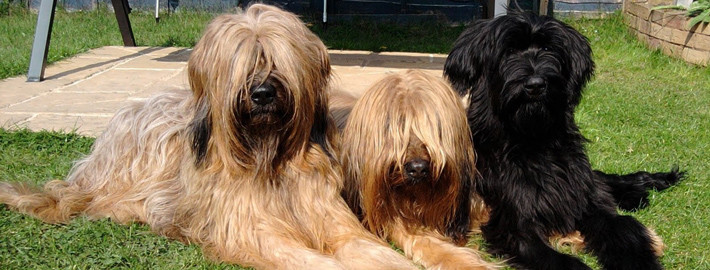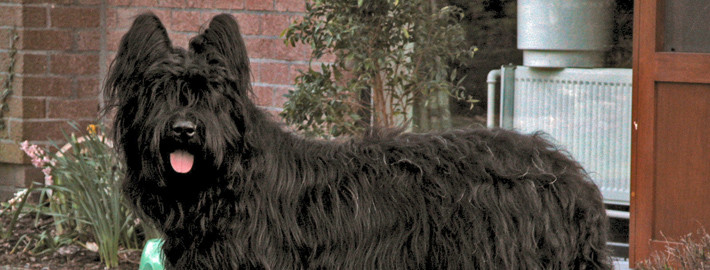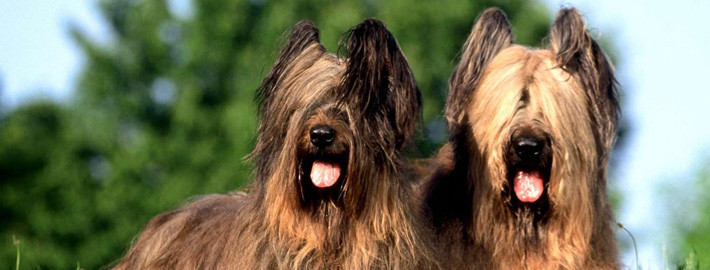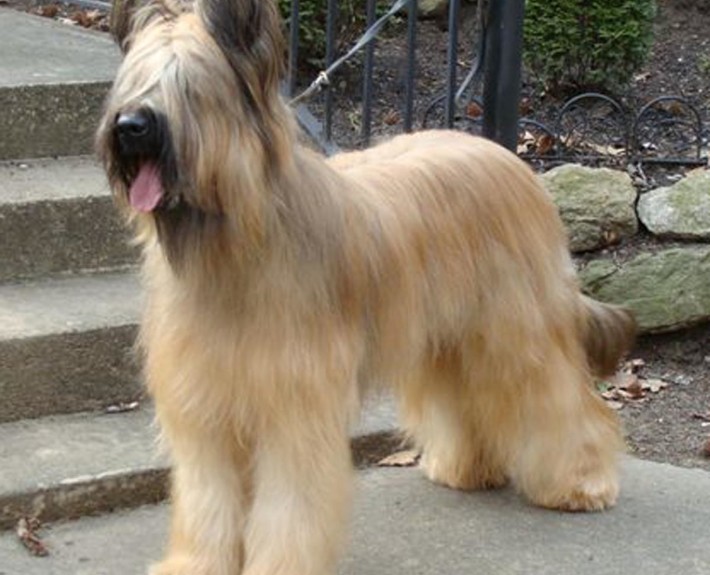What makes the Briard Unique?
Great for active families living on small farms, Briards have a long history of being used as a herding breed.
Page Contents
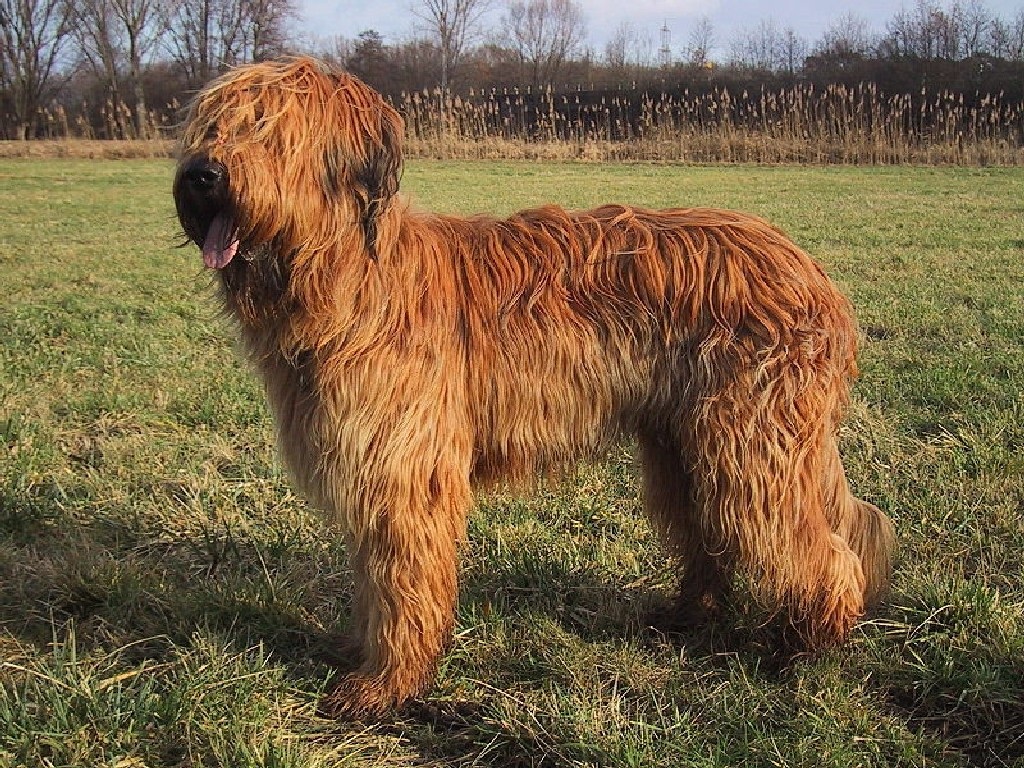
Is the Briard Right For You?
Briards make great partners for adventurous owners, especially when one takes into account that they keep some of their puppy like traits into their later years. These dogs are affectionate guardians that want to please the members of their human families. Their protective instinct starts coming into play when Briards reach a year old. These dogs are also very loyal and tend to shadow their owners. They may even go so far as to protect their owners’ children from any form of corporal punishment that might be doled out by their parents.
These dogs have coats that are resistant to inclement weather and various types of debris but, all the same, they do need a moderate amount of grooming. Any excessive hair in their ears or on their footpads can be clipped in order to help Briards maintain a tidy appearance. It is also a good idea to keep their teeth brush and their nails trimmed.
In 5 Words
- Protective
- Obedient
- Loyal
- Faithful
- Fearless
Characteristics
Learn About the Briard
Description
General Description
Briards have powerful, square-shaped bodies. These large dogs have a build that is somewhat longer than it is tall though this feature is more noticeable on female dogs than their male contemporaries. Briards have a comely form with a level back. They likewise have wide heads and elongated eyebrows. Their black noses are at the end of their wide muzzles and their teeth should come together in a scissors bite. These dogs often have an inquisitive, albeit self-assured, expression in their wide set dark black or brown eyes. However, the lavish coat of the Briard often covers its eyes.
Ears on this breed should not lie flat upon a dog’s head. They should instead be left alone or cropped. Members of this breed are known for their agility and strength, both of which are common characteristics among herding dogs. Briards can stop quickly and elegantly resume their characteristic gliding pace at a moment’s notice. They have rounded feet of considerable size. Another feature of this breed is the double dewclaws on their hind legs, which can be removed or not as the owner sees fit. These dogs also have feathered tails that form the shape of the letter J and are carried low to the ground.
Size
Males of this breed weigh between 66 and 88 pounds (30 and 40 kilograms) and they stand roughly 24 to 27 inches (61 to 69 centimeters) tall. Female Briards are smaller at 55 to 77 pounds (25 to 35 kilograms) in weight and 23 to 26 inches ( 58 to 65 centimeters) in height.
Coat
The Briard has a double coat that gives them a characteristically shaggy appearance. The outer layer is long, coarse, and somewhat wavy. It reaches a length of 6 inches (16 centimeters) or greater when the dog in question reaches adulthood. The undercoat is soft and clings close to the dogs’ bodies. Members of this breed are available in every hue with the exception of white. Grey, black, and tawny Briards are the most common. Those that have tawny colorations may have the hue lighten at first as they age and then turn back to a darker shade.
Short History of the Briard
This French breed has been around since at least the 8th century when it was first depicted in artwork. Four hundred years later, the dogs also began to make their appearance in written works. These sheep herding dogs were historically used as a deterrent against wolves and poaching during the High Middle Ages. Other tasks these dogs have performed throughout the years have included delivering messages, hunting game, and carting packages.
Members of this breed first acquired the moniker Briard around the early 19th century and most believe the designation to mean that these dogs came from that province. However, this name may instead refer to a legendary incident in which a dog belonging Aubry de Montdidier saved his child’s life. After the French Revolution, these dogs became useful in herding sheep on small plots of land rather than just simply guarding them.
The Paris dog show of 1863 helped increase the popularity of these dogs. A breed standard appeared as early as 1897 and the French followed suit by starting a breed club ten years later. During the First World War, so many Briards served the French troops on the front lines and were presumably killed in the line of duty that the dog breed almost ceased to exist. Some of these dogs had been imported to the States much earlier by influential men such as Thomas Jefferson and the Marquis de Lafayette, but the breed finally received official American Kennel Club recognition in 1928.
Temperament
Briards make great partners for adventurous owners, especially when one takes into account that they keep some of their puppy like traits into their later years. These dogs are affectionate guardians that want to please the members of their human families. Their protective instinct starts coming into play when Briards reach a year old. These dogs are also very loyal and tend to shadow their owners. They may even go so far as to protect their owners’ children from any form of corporal punishment that might be doled out by their parents. However, in keeping with their herding abilities, these dogs also see nothing wrong in nipping at people’s feet while playing with them and have to be cured of this habit before it becomes ingrained. Members of this breed tend to be homebodies as well and prefer their people to stay with them. Briards are generally shy and well behaved around unfamiliar persons, but they can be quite aggressive in their dealings with other canines.
Caring for Your Briard
General Health
Although Briards live about 11 years on average, there are nonetheless some health concerns that dog owners will need to keep in mind. Eye problems are a major problem for this breed. Cataracts, blindness, retinal dystrophy, congenital stationary night blindness, and progressive retinal atrophy have all been known to occur in Briards. As is the case with other sizeable dog breeds, there have also been instances of hip dysplasia and bloat in these dogs. Hypothyroidism and lymphoma are likewise problematic from time to time.
Care
Daily
These dogs need good amounts of human interaction and plentiful exercise every single day. Briards love herding other animals but they are equally happy hiking, jogging, or having lengthy play sessions with their owners.
Weekly
Briards need to be brushed several times a week in order to keep their long coats free of mats.
Monthly
All dogs require flea, heartworm and tick prevention medication once a month in order for the products to be effective.
Grooming & Bathing
These dogs have coats that are resistant to inclement weather and various types of debris but, all the same, they do need a moderate amount of grooming. Any excessive hair in their ears or on their footpads can be clipped in order to help Briards maintain a tidy appearance. It is also a good idea to keep their teeth brush and their nails trimmed.
Exercise & Training
While they are friendly towards members of their human family, Briards are not always welcoming to strangers so they should be introduced to new person on their own level. Early socialization is crucial in helping members of this breed determine what could constitute a threat and what does not. These dogs also have good memories and retain lessons for a long time after they are learned.

